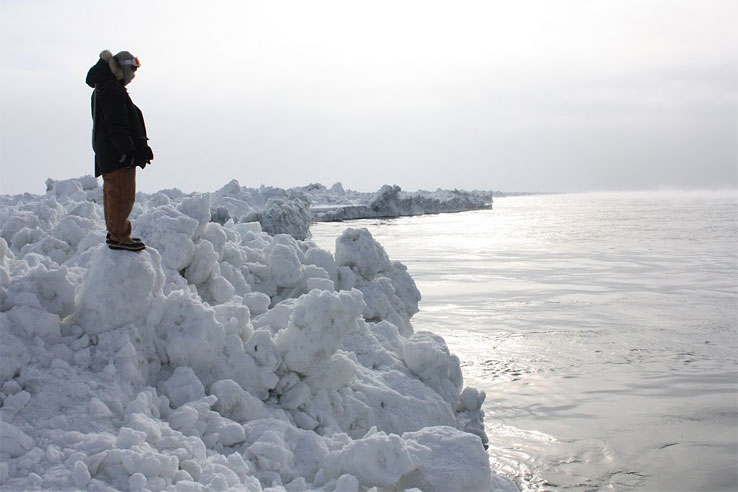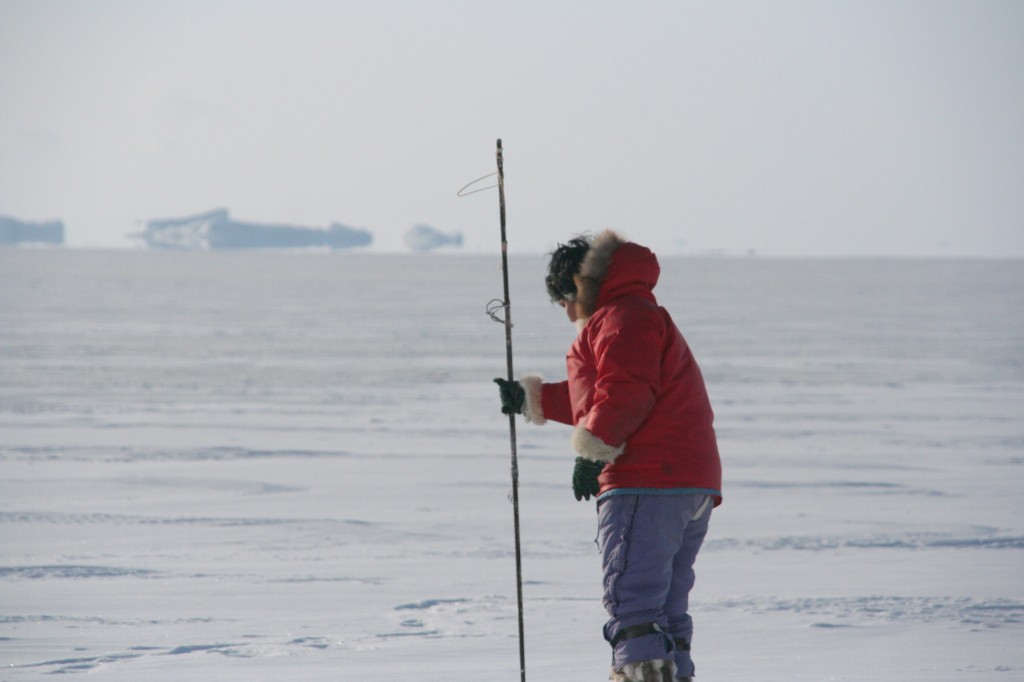by Natasha Vizcarra, NSIDC
An Inuit hunter stands at the edge of the shorefast ice at Barrow, Alaska. Credit: M. Druckenmiller.
A hand-drawn map; an Elder’s account of an old hunting route; reports of new leads in the sea ice: Inuit hunters in the small hamlet of Sanikiluaq in Nunavut, Canada—and elsewhere in the Arctic circle—depend on these year-round to navigate the region’s changing landscape of ice. The same knowledge provides climate researchers valuable observations they may not even detect using advanced Earth-observing satellites.
Community Elders have curated local and traditional knowledge of the ice for many years. However, this curation depends heavily on person-to-person transmission in a close-knit community. And each year, some young members of the community might be drawn off by the wider world, or they may not speak the community language as well as their parents. “This type of knowledge transmission has been disrupted by outside interventions, changes in local economies, and changes in the use of traditional languages,” said Peter Pulsifer, a geographer and the principal investigator for the Exchange for Local Observations and Knowledge of the Arctic (ELOKA).
So communities are looking to technology to avert the loss of knowledge. The ELOKA project has been connecting Arctic communities with visiting scientists since 2007, facilitating the collection, preservation, exchange, and use of such local observations in the Arctic. Today, they have a wealth of data. Elders and scientists have collaborated on written interview transcripts, audio or videotapes and files, photographs, artwork, and maps. They also have quantitative data such as temperature, snow thickness, and wind data, and newer digital data such as GPS tracks.
 NSIDC researcher Shari Gearheard (right) and hunter Lasalie Jonasie (left) keep an eye on a polar bear while traveling on Arctic sea ice. Gearheard is part of ELOKA, a unique effort to document local and traditional environmental knowledge in the Arctic. Credit: E. Wingate
NSIDC researcher Shari Gearheard (right) and hunter Lasalie Jonasie (left) keep an eye on a polar bear while traveling on Arctic sea ice. Gearheard is part of ELOKA, a unique effort to document local and traditional environmental knowledge in the Arctic. Credit: E. Wingate
Not your usual type of data
Still, the types of knowledge repositories used by Western scientists can be limiting. For example, the death of reindeer in the Kolyma River region in Siberia can be explained by herders who have reported a new weather phenomenon during winters—ice rain has been freezing the lichen pastures that the reindeer depend on. Traditional knowledge, which is sometimes preserved in songs, poems, and drawings and not in number tables or graphs, does not recall such events from the past.
“My experience in working with community members is that their priority and focus is on knowledge, particularly understanding the myriad relationships between and among physical, human, animal, and in some cases spiritual worlds.” Pulsifer said. “Documenting this knowledge creates what many people consider to be ‘data,’ however this data is often not in the form of numbers in a table of data. In fact, reducing the knowledge to a set of numbers can, in some cases, lose valuable contextual information that can misrepresent the original knowledge.”
ELOKA needed a better way to preserve this unique constellation of data types and data relationships, and make sure these survive the rapid changes in technology. Pulsifer said the project has chosen to collaborate with the Data Conservancy because it understands ELOKA’s unique challenges. “They are willing to adapt the Data Conservancy system to meet the needs of Arctic communities and researchers, so the data user has a more holistic understanding of the data we are striving to preserve,” he said.
Toku Oshima tests the ice before proceeding with his sled and dogs in Avannaa, Greenland. Hunters like Oshima provide valuable observations of sea ice. Credit: A. Mahoney/NSIDC
A flexible model
It is a great match. At the heart of the Data Conservancy is a flexible data model, which allows the system to manage and preserve diverse types of data. Its Feature Extraction Framework generates rich results from crosscutting queries and gives users both the power and the flexibility to work meaningfully with diverse knowledge and data.
For starters, ELOKA has been using the Data Conservancy software to help with the management of digital files generated through a research project with the community of Sanikiluaq in Nunavut, Canada. “We are using the DC system used to store a variety of different files, such as text, images, video, maps, an entire website, and related descriptive information about the files and their relationships,” Pulsifer said. When Elders and collaborating researchers upload their data, system extracts metadata that these data providers can edit. The system relies on the metadata to make the collections easy to discover by researchers from diverse disciplines.
“We stand to gain a much more flexible preservation system, one that can represent the complex relationships based on the needs of knowledge holders and researchers rather than one that strictly organizes knowledge based on an outside system, such as a library catalog,” Pulsifer said.
In turn, ELOKA provides the Data Conservancy with “real world examples of the needs of end users, along with a clear explanation of why particular features are required,” Pulsifer said. While ELOKA’s data is different from most other research data, the data management features being developed for the project can be useful to researchers in integrative fields. “They are very relevant for researchers in fields such as ecology and geography, where they considering physical and biological systems, including humans and social sciences,” Pulsifer said. “As a geographer, I see similarities in theory and methodology.”
The Data Conservancy community provides software for research communities based on industry best practices, the open archival information system (OAIS) reference model, service-oriented architecture (SOA), metadata standards, and much more.
To learn more about the Data Conservancy capabilities, visit http://dataconservancy.wpshared.library.jhu.edu/software.

